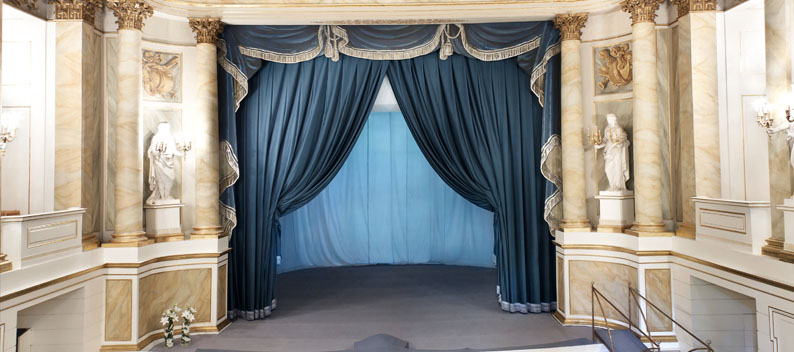Part Three: The Baroque Period
At the end of the 17th century, improvements in glass manufacture, such as the invention of cast glass plate, meant that at least for the wealthy, larger windows began to replace shutters and draperies became lavish, often very long and puddling onto the floor. The emphasis on gardens and garden views was a trend of the Queen Anne era, and interiors were meant to bring the outside in by means of elaborate patterns of flowers and climbing vines suggestive of summer in damp English climes. For this reason bright hues of blue, green or mustard were particularly popular, though these mellowed as the century went on.
Fabrics were equally voluptuous, featuring brocade, velvet and damask or cotton chintz which was silk screened or block printed, also featuring Chinese motifs and shells inspired by the court of William and Mary and their love of Dutch interiors. Some curtains only fell to the windowsill while others were left long to billow over the carpets and were usually patterned to match other textiles in the rooms, if not identical to them.
Silk comes home – curtain design evolves
While silk was still only for the very wealthy, the industry was expanding in Europe due to increasing demand, with silk velvet was the most costly of all followed by damasks and brocades. Most was initially produced in Italy, with Genoa particularly famed for its multicoloured, large-patterned floral velvets with large-scale patterns intended specifically for home interiors. In France, Lyon was the centre of silk production but later the flight of Huguenot artisans to Spitalfields in East of London meant that quality silks were manufactured much closer to home, but English designers moved on from the prevailing French florals by introducing simpler patterns based on botanical specimens or engravings. Simpler homes used woollen or calico fabrics.
Curtains in wealthy homes were almost always paired and tied back low with elegant fringes, braid, ropes or tassels, and the top treatment was equally detailed, with pelmets and valances displaying embroideries, sculptured edgings, or designed and shaped as part of the elegant cornices and mouldings typical of the period. Curtain hardware was concealed by the pelmets and sometimes built into panelled shutters that receded into the wall.
Into the Light – roller blinds begin
Perhaps because of the increasing size of windows during the Queen Anne era curtains had a specific definition as fabric which could be expanded or contracted at will to let light in or block it out, showing that the idea of any serious amount daylight entering the home was novel. Thus, for the sake of expensive textile protection and privacy, the sheer ‘glass curtain’ made of lace or linen began to be used with the first roller blinds appearing in England in the early 18th century. What is certainly known, however, is that roller shades were in use in Holland as early as the 17th Century and thus would have been noted by William and Mary as they popularized the comforts and cleanliness of wealthy Dutch homes.
What we know today as “Venetian Blinds” were patented by Edward Bevan London in 1769, but their use is much older, probably dating from Venetians traders who brought the idea of the blind from Persia to France as the French name for them is “Les Persienes” and in Italy “Persiana.”
Return in two weeks for Part Four: The Neo-Classical Era




